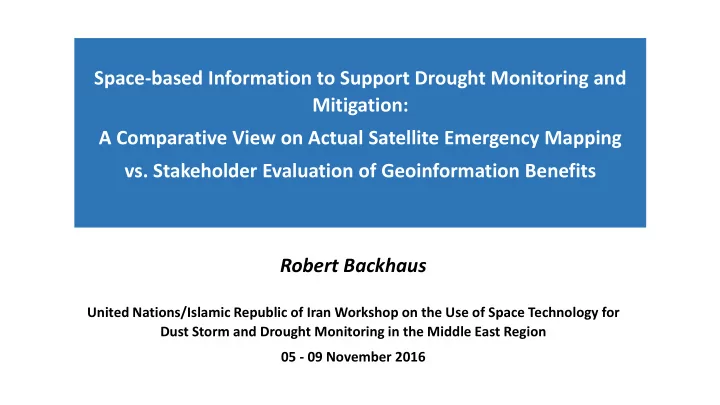

Space-based Information to Support Drought Monitoring and Mitigation: A Comparative View on Actual Satellite Emergency Mapping vs. Stakeholder Evaluation of Geoinformation Benefits Robert Backhaus United Nations/Islamic Republic of Iran Workshop on the Use of Space Technology for Dust Storm and Drought Monitoring in the Middle East Region 05 - 09 November 2016
The challenge: Vast range of harmful effects and collateral hazards of drought! Water shortage Crops and livestock losses Famine Migration Dust storm Wildfire Soil erosion Desertification
The Space-based potential: Mapping and monitoring from satellites facilitated by • variety of observable drought parameters • spatial and temporal extension Likely assumption: Widespread Space-based drought mapping and monitoring activities in regions affected/at risk
The Space-based potential: Mapping and monitoring from satellites facilitated by • variety of observable drought parameters • spatial and temporal extension Likely assumption: Widespread Space-based drought mapping and monitoring activities in regions affected/at risk (???) To be checked by comparing data from two thematic studies!
Two global studies addressing (i) Actual Satellite Emergency Mapping and (ii) Stakeholder Evaluation of Geoinformation Benefits: ( i ) Voigt et al. (2016): Global trends in satellite based emergency mapping. Science, Vol. 353(6296):247-252. http://science.sciencemag.org/content/353/6296/247 ( ii ) Altan et al. (2013): The Value of Geoinformation for Disaster and Risk Management (VALID) – Benefit Analysis and Stakeholder Assessment . JBGIS, Copenhagen, Denmark. http://www.un-spider.org/VALID-stakeholder-assessment-I
Voigt et al. (2016): Global trends in satellite based emergency mapping • Comprehensive study covering a total of 1,080 mapping activations for 163 countries from 2000 – 2014. • Spatial correlation of activations with population density • Activation statistics specified for disaster types Flood (50%) Wildfire (8%) Storm (18%) Landslide (5%) Earthquake (10%)
Voigt et al. (2016): Global trends in satellite based emergency mapping • Comprehensive study covering a total of 1,080 mapping activations for 163 countries from 2000 – 2014. • Spatial correlation of activations with population density • Activation statistics specified for disaster types Flood (50%) Wildfire (8%) Storm (18%) Landslide (5%) Earthquake (10%) Drought ???
Voigt et al. (2016): Global trends in satellite based emergency mapping • Drought subsumed under “Others” (9%)
Voigt et al. (2016): Global trends in satellite based emergency mapping • Drought subsumed under “Others” (9%) Drought emergency mapping distinctly underrepresented in comparison with other disaster types! The authors emphasize the need for improved SEM coverage of slow-onset disasters such as drought!
Altan et al. (2016): The Value of Geoinformation for Disaster and Risk Management (VALID) – Benefit Analysis and Stakeholder Assessment Approach: Longlist of 52 DRM-relevant geoinformation products/systems identified from recent publications Reference set of 10 top-priority geoinformation products/systems shortlisted through a global web-based stakeholder poll (1 st global poll in 2011, participants 222) Benefit evaluation of reference items by specific criteria through stakeholders (2 nd global poll in 2013, participants 70)
Drought Index Map for Soil Moisture Monitoring Drought Index Map for Vegetation Monitoringg 1st global poll results: Drought Index Map Ranking of Drought-related Drought Risk Map items Drought Vulnerability Map
Hazard Type Product/System Counts Flood Flood Risk Monitoring System 97 Flood Risk Map 95 Damage Assessment Map 82 1st global poll Inundation Map 67 results: Top-10 Earthquake Urban Classification for Risk 85 Analysis reference items Damage Assessment Map 83 for benefit Drought Vulnerability Map 76 evaluation Fire Risk Map 74 Detection and Monitoring System 67 Landslide Landslide Hazard Assessment 68
Irene Angelucetti and Francesca Perez: Drought hazard assessment and vulnerability mapping. In: Altan et al. (2013) pp. 54 – 61. Drought Vulnerability Map State-of-the-art technical profile (features and parameters) Appraisal results
Technical profile for Drought Vulnerability Map Topic Regional vulnerability to economic, environmental, or social impacts of drought Thematic content 8 drought vulnerability classes based on socio-economic data (such as gross domestic product per capita, dependence on agriculture for income and employment, total and rural population) biophysical data (such as land cover , annual precipitation and river discharge, soil depth, soil degradation) Access Upon registration via internet Scale Not applicable Accuracy Not applicable Areal coverage Global/Regional Spatial resolution 0.5° x 0.5° (average) for global raster datasets used for drought vulnerability indicators / national aggregation level for socioeconomic data Timeliness Not relevant for vulnerability assessment Update frequency 2 - 10 years Data format Raster Maps and vector datasets (OGC standard)
Evaluation results summary: Drought Vulnerability Map Fields of priority as evaluated by Non-end-users End-users Operational Benefits Health care Humanitarian aid Strategic Benefits Support of preventive strategies Support of superregional consistency and cooperation Efficiency of plans and policies Criticality of specific features Areal coverage Thematic content Access
Evaluation results summary: Drought Vulnerability Map Needs for disaggregated socio-economic data! Drought vulnerability maps should be developed well in advance of the onset of a drought! Preparedness and response to drought disasters should also be supported by timely drought hazard assessment and monitoring.
Some concluding points Low numbers in SEM activations for drought seem to correspond with user requirements for more complex mapping products for vulnerability and risk assessment to support operational as well as preventive actions. Availability of suitable socio-economic data is a bottleneck for regional drought vulnerability and risk assessment. Drought hazard may be mitigated through regionally adapted measures to downscale the water cycle by programmes such as o Afforestation o Reforestation o Agroforestry. Satellite Remote Sensing is the method of choice for monitoring such programmes!
Some food for thought Ripl, W. (1995): Management of water cycle and energy flow for ecosystem control: The energy-transport-reaction (ETR) model. Ecol. Modelling 78, 61-79 Gumbricht, T. (1996): Modelling water and vegetation reciprocity – A landscape synthesis in GIS . Royal Institute of Technology, Stockholm, Sweden
Some food for thought Ripl, W. (1995): Management of water cycle and energy flow for ecosystem control: The energy-transport-reaction (ETR) model. Ecol. Modelling 78, 61-79 Gumbricht, T. (1996): Modelling water and vegetation reciprocity – A landscape synthesis in GIS . Royal Institute of Technology, Stockholm, Sweden Thank you for your attention and patience!
Recommend
More recommend